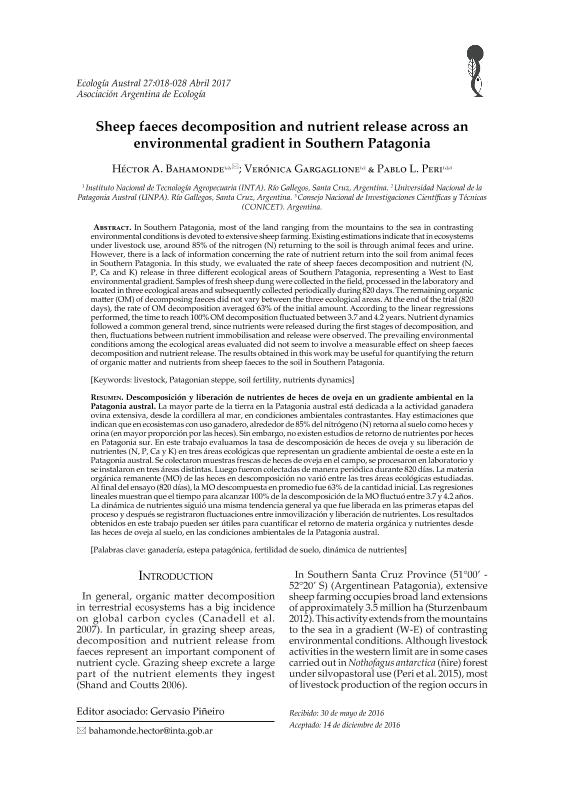Mostrar el registro sencillo del ítem
dc.contributor.author
Bahamonde, Héctor Alejandro

dc.contributor.author
Gargaglione, Veronica Beatriz

dc.contributor.author
Peri, Pablo Luis

dc.date.available
2019-03-29T17:38:04Z
dc.date.issued
2017-02
dc.identifier.citation
Bahamonde, Héctor Alejandro; Gargaglione, Veronica Beatriz; Peri, Pablo Luis; Sheep faeces decomposition and nutrient release across an environmental gradient in Southern Patagonia; Asociación Argentina de Ecología; Ecología Austral; 27; 1; 2-2017; 18-28
dc.identifier.issn
0327-5477
dc.identifier.uri
http://hdl.handle.net/11336/72842
dc.description.abstract
La mayor parte de la tierra en la Patagonia austral está dedicada a la actividad ganadera ovina extensiva, desde la cordillera al mar, en condiciones ambientales contrastantes. Hay estimaciones que indican que en ecosistemas con uso ganadero, alrededor de 85% del nitrógeno (N) retorna al suelo como heces y orina (en mayor proporción por las heces). Sin embargo, no existen estudios de retorno de nutrientes por heces en Patagonia sur. En este trabajo evaluamos la tasa de descomposición de heces de oveja y su liberación de nutrientes (N, P, Ca y K) en tres áreas ecológicas que representan un gradiente ambiental de oeste a este en la Patagonia austral. Se colectaron muestras frescas de heces de oveja en el campo, se procesaron en laboratorio y se instalaron en tres áreas distintas. Luego fueron colectadas de manera periódica durante 820 días. La materia orgánica remanente (MO) de las heces en descomposición no varió entre las tres áreas ecológicas estudiadas. Al final del ensayo (820 días), la MO descompuesta en promedio fue 63% de la cantidad inicial. Las regresiones lineales muestran que el tiempo para alcanzar 100% de la descomposición de la MO fluctuó entre 3.7 y 4.2 años. La dinámica de nutrientes siguió una misma tendencia general ya que fue liberada en las primeras etapas del proceso y después se registraron fluctuaciones entre inmovilización y liberación de nutrientes. Los resultados obtenidos en este trabajo pueden ser útiles para cuantificar el retorno de materia orgánica y nutrientes desde las heces de oveja al suelo, en las condiciones ambientales de la Patagonia austral.
dc.description.abstract
In Southern Patagonia, most of the land ranging from the mountains to the sea in contrasting environmental conditions is devoted to extensive sheep farming. Existing estimations indicate that in ecosystems under livestock use, around 85% of the nitrogen (N) returning to the soil is through animal feces and urine. However, there is a lack of information concerning the rate of nutrient return into the soil from animal feces in Southern Patagonia. In this study, we evaluated the rate of sheep faeces decomposition and nutrient (N, P, Ca and K) release in three different ecological areas of Southern Patagonia, representing a West to East environmental gradient. Samples of fresh sheep dung were collected in the field, processed in the laboratory and located in three ecological areas and subsequently collected periodically during 820 days. The remaining organic matter (OM) of decomposing faeces did not vary between the three ecological areas. At the end of the trial (820 days), the rate of OM decomposition averaged 63% of the initial amount. According to the linear regressions performed, the time to reach 100% OM decomposition fluctuated between 3.7 and 4.2 years. Nutrient dynamics followed a common general trend, since nutrients were released during the first stages of decomposition, and then, fluctuations between nutrient immobilisation and release were observed. The prevailing environmental conditions among the ecological areas evaluated did not seem to involve a measurable effect on sheep faeces decomposition and nutrient release. The results obtained in this work may be useful for quantifying the return of organic matter and nutrients from sheep faeces to the soil in Southern Patagonia.
dc.format
application/pdf
dc.language.iso
eng
dc.publisher
Asociación Argentina de Ecología

dc.rights
info:eu-repo/semantics/openAccess
dc.rights.uri
https://creativecommons.org/licenses/by-nc-sa/2.5/ar/
dc.subject
Livestock
dc.subject
Soil Fertility
dc.subject
Nutrients Dynamics
dc.subject
Patagonian Steppe
dc.subject.classification
Otras Producción Animal y Lechería

dc.subject.classification
Producción Animal y Lechería

dc.subject.classification
CIENCIAS AGRÍCOLAS

dc.title
Sheep faeces decomposition and nutrient release across an environmental gradient in Southern Patagonia
dc.title
Descomposición y liberación de nutrientes de heces de oveja en un gradiente ambiental en la Patagonia austral
dc.type
info:eu-repo/semantics/article
dc.type
info:ar-repo/semantics/artículo
dc.type
info:eu-repo/semantics/publishedVersion
dc.date.updated
2019-03-29T12:05:05Z
dc.journal.volume
27
dc.journal.number
1
dc.journal.pagination
18-28
dc.journal.pais
Argentina

dc.description.fil
Fil: Bahamonde, Héctor Alejandro. Universidad Nacional de la Patagonia Austral. Unidad Académica Río Gallegos; Argentina. Instituto Nacional de Tecnología Agropecuaria; Argentina
dc.description.fil
Fil: Gargaglione, Veronica Beatriz. Universidad Nacional de la Patagonia Austral. Unidad Académica Río Gallegos; Argentina. Instituto Nacional de Tecnología Agropecuaria; Argentina. Consejo Nacional de Investigaciones Científicas y Técnicas; Argentina
dc.description.fil
Fil: Peri, Pablo Luis. Universidad Nacional de la Patagonia Austral. Unidad Académica Río Gallegos; Argentina. Instituto Nacional de Tecnología Agropecuaria; Argentina. Consejo Nacional de Investigaciones Científicas y Técnicas; Argentina
dc.journal.title
Ecología Austral

dc.relation.alternativeid
info:eu-repo/semantics/altIdentifier/url/http://ojs.ecologiaaustral.com.ar/index.php/Ecologia_Austral/article/view/377
Archivos asociados
